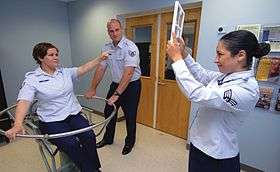Bárány chair
The Barany chair or Bárány chair, named for the Hungarian physiologist Robert Bárány, is a device used for aerospace physiology training, particularly for student pilots.
| Bárány chair | |
|---|---|
 Air Force personnel demonstrating the effect on the sensory perception and spatial orientation of a test person in a Bárány chair. After first having been rotated in the chair and then stopped, the test person tries to point at a test board. | |
| ICD-9-CM | 95.45 |
Test
The subject is placed in the chair, blindfolded, then spun about the vertical axis while keeping their head upright or tilted forward or to the side. The subject is then asked to perform tasks such as determine their direction of rotation while blindfolded, or rapidly change the orientation of their head, or attempt to point at a stationary object without blindfold after the chair is stopped. The chair is used to demonstrate spatial disorientation effects, proving that the vestibular system is not to be trusted in flight. Pilots are taught that they should instead rely on their flight instruments.
Uses
The device is also used in motion sickness therapy.
Nobel Prize
Bárány used this device in his research into the role of the inner ear in the sense of balance, for which he won the 1914 Nobel prize in Physiology or Medicine.
See also
- Sensory illusions in aviation
- Spatial disorientation – Inability of a person to correctly determine their body position in space
References